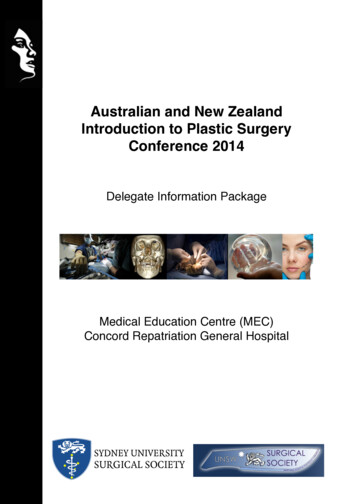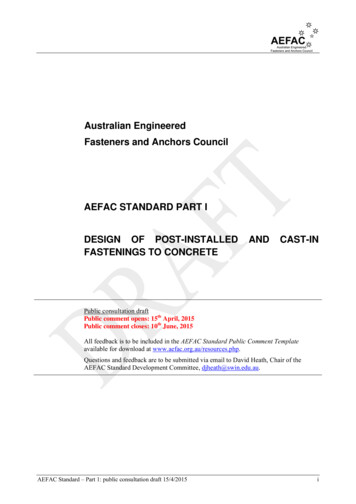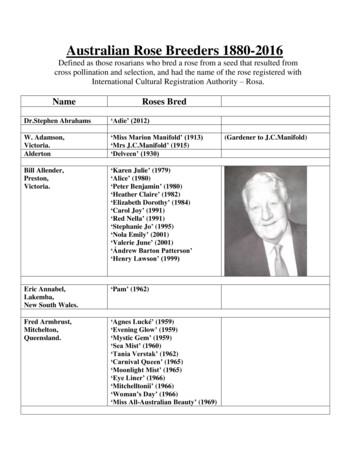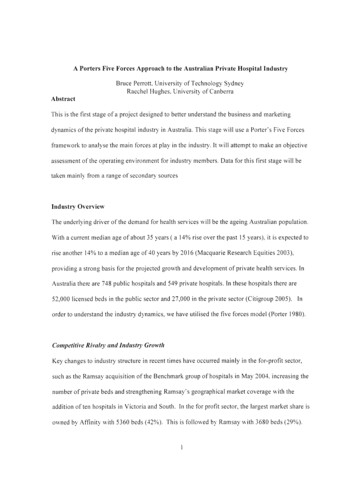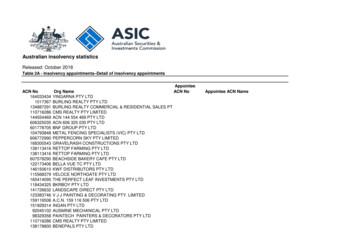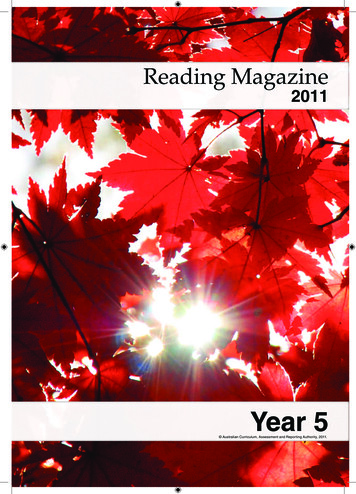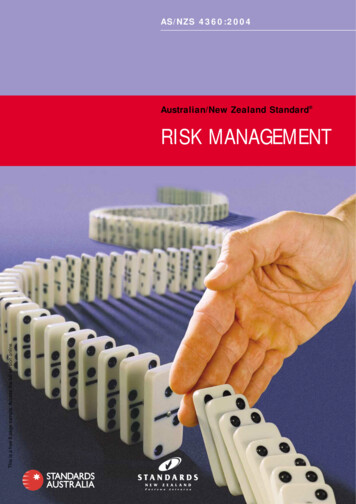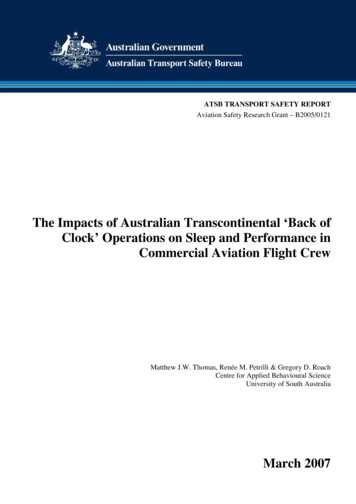
Transcription
ATSB TRANSPORT SAFETY REPORTAviation Safety Research Grant – B2005/0121The Impacts of Australian Transcontinental ‘Back ofClock’ Operations on Sleep and Performance inCommercial Aviation Flight CrewMatthew J.W. Thomas, Renée M. Petrilli & Gregory D. RoachCentre for Applied Behavioural ScienceUniversity of South AustraliaMarch 2007
ATSB TRANSPORT SAFETY REPORTAviation Safety Research Grant - B2005/0121The Impacts of Australian Transcontinental‘Back of Clock’ Operations onSleep and Performance inCommercial Aviation Flight CrewMatthew J.W. Thomas, Renée M. Petrilli & Gregory D. RoachCentre for Applied Behavioural ScienceUniversity of South AustraliaMarch 2007
Published by:Australian Transport Safety BureauPostal address: PO Box 967, Civic Square ACT 2608Office location: 15 Mort Street, Canberra City, Australian Capital TerritoryTelephone:1800 621 372; from overseas 61 2 6274 6590Facsimile:02 6274 6474; from overseas 61 2 6274 ov.auAviation Safety Research Grants ProgramThis report arose from work funded through a grant under the Australian Transport Safety Bureau’s AviationSafety Research Grants Program. The ATSB is an operationally independent bureau within the AustralianGovernment Department of Transport and Regional Services. The program funds a number of one-offresearch projects selected on a competitive basis. The program aims to encourage researchers from a broadrange of related disciplines to consider or to progress their own ideas in aviation safety research.The work reported and the views expressed herein are those of the author(s) and do not necessarily representthose of the Australian Government or the ATSB. However, the ATSB publishes and disseminates the grantreports in the interests of information exchange and as part of the overall safety aim of the grants program. University of South Australia 2007– ii –
CONTENTSACKNOWLEDGEMENTS . viABBREVIATIONS AND DEFINITIONS. viiEXECUTIVE SUMMARY . ix1INTRODUCTION . 11.12Sleep and fatigue. 11.1.2Fatigue and circadian disruption. 21.1.3Consequences of fatigue – performance and safety. 2Transcontinental ‘back of clock’ operations. 31.3Fatigue risk management. 4METHODOLOGY . 52.1Participants . 52.2Design and procedure . 52.3Materials . 52.3.1Activity monitor. 52.3.2Sleep and duty diary . 62.3.3Psychomotor vigilance task (PVT) . 6Measures. 72.4.1Prior sleep and wake . 72.4.2Duty times. 82.4.3Subjective fatigue . 82.4.4Neurobehavioural performance . 8RESULTS . 93.141.1.11.22.43Fatigue, shiftwork and performance . 1Prior sleep and wake. 93.1.1Take-off . 93.1.2Landing . 113.1.3Summary. 133.2Neurobehavioural performance . 153.3Subjective fatigue . 173.3.1Take-off . 173.3.2Landing . 18DISCUSSION . 214.1Back of clock operations, sleep, and performance . 21– iii –
4.2Fatigue risk management systems (FRMS) . 225CONCLUSIONS . 256REFERENCES. 27– iv –
DOCUMENT RETRIEVAL INFORMATIONReport No.B2005/0121Publication dateMarch 2007No. of pages42ISBN978 1 921164 56 9Publication titleThe Impacts of Australian Transcontinental ‘Back of Clock’ Operations on Sleep andPerformance in Commercial Aviation Flight CrewAuthor(s)Thomas, Matthew J. W.; Petrilli, Renée, M.; and Roach, Gregory, D.Organisation that prepared this documentUniversity of South AustraliaGPO Box 2471, Adelaide SA 5001 Australiahttp://www.unisa.edu.au/safetyReference No.Mar2007/DOTARS 50171Funded byAustralian Transport Safety BureauPO Box 967, Civic Square ACT 2608 Australiawww.atsb.gov.auAbstractThis aim of the study was to provide objective data to inform fatigue risk-management processesby determining the quantity and quality of sleep obtained by airline pilots during transcontinental‘back of clock’ operations, and any changes to subjective fatigue and neurobehaviouralperformance during these sectors. Typical transcontinental back of clock route pairings involve adeparture close to midnight Perth local time, with a dawn arrival into an East-coast city such asMelbourne, Sydney or Brisbane. In many instances this first sector is followed by a second sectorto another east-coast destination, with sign-off at approximately 0900 Eastern Standard Time.Data were collected by participants during a two-week period of a normal rostered flying for anairline. During each of the 14 days of data collection, participants were required to undertake thefollowing: 1) Wear an activity monitor wristwatch 7 days prior to, and 6 days after, atranscontinental back of clock flight; 2) complete sleep and duty diaries, which record time ofsleep, subjective alertness, and time of duty; and 3) complete a simple 5-minute PsychomotorVigilance Task (reaction time task) during the cruise of each sector, and three times on non-flyingdays. The results of this study suggest that Australian transcontinental back of clock operations, asoperated by the airline involved in this study, differed significantly from a baseline sample ofdaytime duty periods in a number of important areas with respect to prior sleep, neurobehaviouralperformance, and subjective fatigue. While there were some significant differences in sleep andsubjective fatigue as a function of a single transcontinental sector of back of clock flying, thesedifferences were, on average, of a magnitude that was unlikely to impact on flight crewperformance and overall safety. However, when a primary transcontinental sector is followed byan additional east-coast sector, there is evidence of reduced prior sleep, impairedneurobehavioural performance, and high levels of subjective fatigue.– v –
ACKNOWLEDGEMENTSThe authors acknowledge the funding support provided by the AustralianGovernment, through the Australian Transport Safety Bureau’s Aviation SafetyResearch Program.Sincere thanks goes to the airline that supported this study through access to theircrew, and to the many pilots who volunteered as participants for data collection inthis study. The authors acknowledge the somewhat onerous nature of the researchprotocol employed in this study, and we thank all the pilots who approached thestudy with dedication and professionalism.Thanks also to the Walter Reed Army Institute of Research, for the use of the PalmPVT software in this research.– vi –
ABBREVIATIONS AND DEFINITIONSAbbreviationsANOVAAnalysis of varianceATSBAustralian Transport Safety BureauBACBlood alcohol concentrationFRMSFatigue risk management systemPDAPersonal digital assistantPVTPsychomotor vigilance taskDefinitionsActigraphic dataData from activity monitors that provide information on thelevel of physical activity/movement of an individual.Back of clockWork schedules that involve extended periods of night-workbetween midnight and dawn.Duty periodThe period between commencement and end of all duties.Off-blocksThe commencement of a flight sector.On-blocksThe end of a flight sector.Polyphasic sleepSleep taken in multiple episodes, typically, repeated sleeps ofduration between one and four hours.Red eye flightA flight with a midnight departure from the west coast ofAustralia and a dawn arrival into an east coast destination.SectorAn individual flight.– vii –
– viii –
EXECUTIVE SUMMARYWork-related fatigue presents a significant risk to aviation safety. Recent incidentsinvolving the Australian transcontinental ‘back of clock’ operations of commercialcarriers have been investigated by the Australian Transport Safety Bureau (ATSB),and negative safety outcomes have been attributed to fatigue-related factors. Withinthe domestic Australian aviation context, transcontinental operations present an areawhere the effective management of fatigue is critical. This is especially the casewith late evening departures from Perth for early morning arrivals on the east coast,with a range of different rostering approaches to building duty structures - thecombination of sectors flown, duty periods, and layovers within these city pairings.However, as transcontinental night-work continues because of operational demands,the challenge is to quantify the risks associated with this work, and providesufficient scientific data to assist in safe rostering practices. Typicaltranscontinental back of clock route pairings involve a departure close to midnightPerth local time, with a dawn arrival into an east coast city such as Melbourne,Sydney or Brisbane. This sector is colloquially known by some as a red eye flight.In many instances this first sector is followed by a second sector to another eastcoast destination with sign-off at approximately 0900 Eastern Standard Time.The aim of the study was to provide objective data to inform fatigue riskmanagement processes by determining the quantity and quality of sleep obtained byairline pilots during transcontinental back of the clock operations, and any changesto subjective fatigue and neurobehavioural performance during these sectors.Participants in the study were Captains and First-Officers flying for an airline thathad given permission for their crew to be invited to participate in the study, andwere recruited through an information circular distributed by the airline. The studyprotocol was approved by the Human Research Ethics Committee at the Universityof South Australia. A total pool of 82 volunteers was recruited to participate in thestudy. In total, 37 pilots undertook data collection, yielding 22 complete data sets.The occurrence of operational changes to rosters, where a rostered back of clockoperation was not flown due to crew changes, as well as equipment failures, led to asignificant proportion of data loss.Data were collected by participants during a 2-week period of a normal roster offlying for an airline. Data were collected 7 days prior to, during, and 6 days after atranscontinental back of clock sector operated by the participant. During each of the14 days of data collection, participants were required to undertake the following:1.Wear an activity monitor wristwatch (7 days prior to, and 6 days after, atranscontinental back of clock flight);2.Complete sleep and duty diaries, which record time of sleep, subjectivealertness, and time of duty; and3.Complete a simple 5-minute psychomotor vigilance task or PVT (reaction timetask) during the cruise of each sector, and three times on non-flying days.– ix –
The results of this study suggest that Australian transcontinental back of clockoperations, as operated by the airline involved in this study, differed significantlyfrom a baseline sample of daytime duty periods in a number of important areas withrespect to prior sleep, neurobehavioural performance, and subjective fatigue. Whilethere were some significant differences in sleep and subjective fatigue as a functionof a single transcontinental sector of back of clock flying, on average thesedifferences were of a magnitude that was unlikely to impact on flight crewperformance and overall safety.However, when a primary transcontinental sector is followed by an additional eastcoast sector there is evidence of reduced prior sleep, impaired neurobehaviouralperformance, and high levels of subjective fatigue.During these secondary back of clock sectors, crews had obtained on averagesignificantly less sleep in the 48 hours prior to both take-off and landing, comparedwith a baseline of daytime sectors. It was observed that on landing crew had a meanlevel of sleep in the prior 24 hours, and an average across the prior 48 hours, below5.5 hours per night. This study also demonstrated that subjective fatigue duringthese second back of clock s
‘back of clock’ operations, and any changes to subjective fatigue and neurobehavioural performance during these sectors. Typical transcontinental back of clock route pairings involve a departure close to midnight Perth local time, with a dawn arrival into an East-coast city such as Melbourne, Sydney or Brisbane. In many instances this first sector is followed by a second sector
